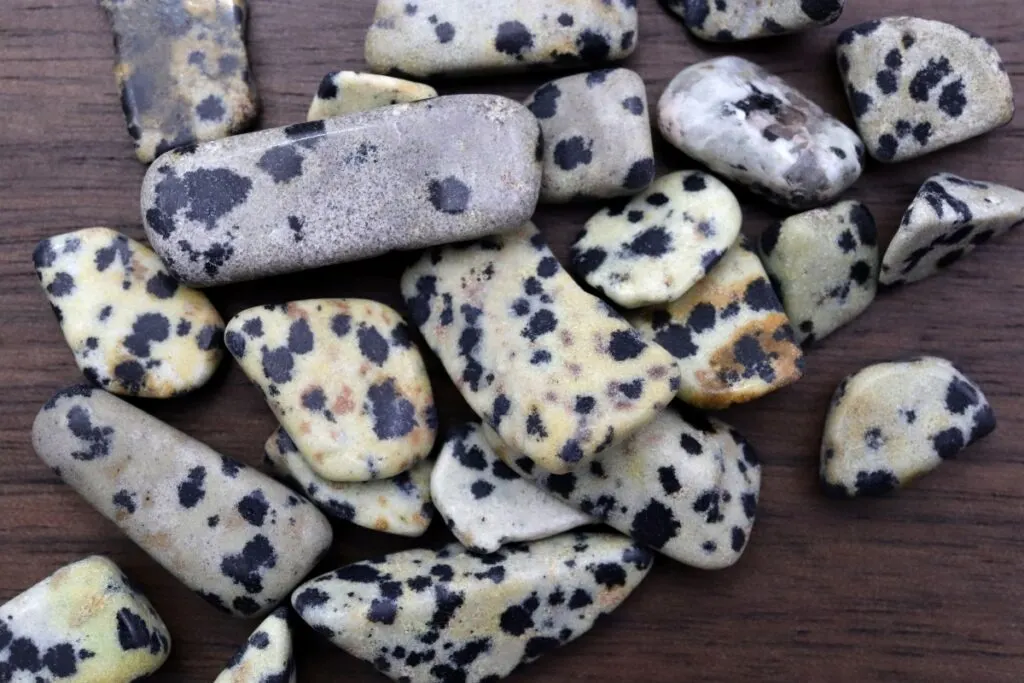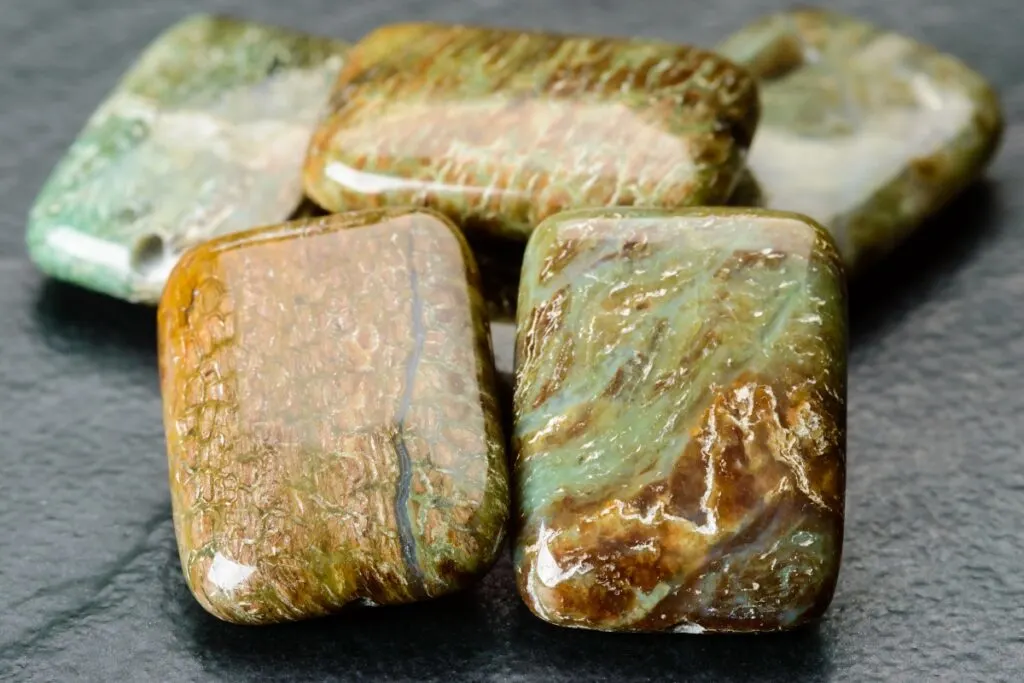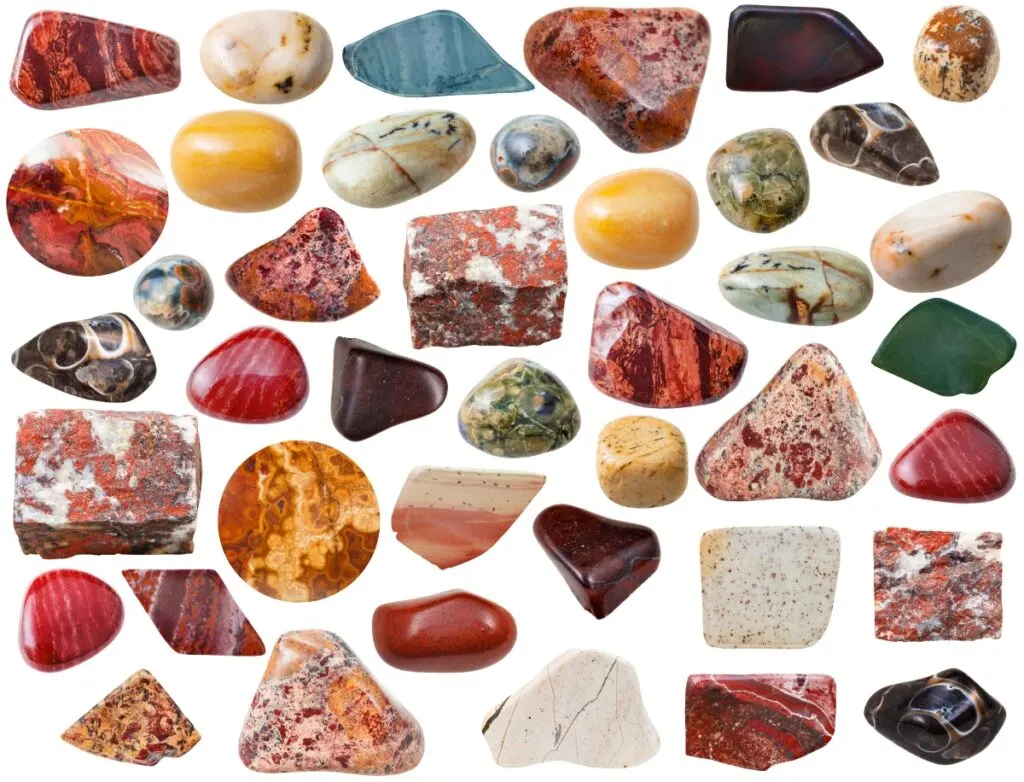As an Amazon Associate, I earn from qualifying purchases with no additional costs for you.
Jasper is one of the most widespread gemstones with some very distinct properties for identifying real stones. Most probably, you have already seen jasper. It is pervasive on a lake and river beads, and seasides.
To identify real jasper, watch through it in the sun or kit with a flashlight. Real jasper is opaque and doesn’t transmit light. The second distinctive feature is hardness. Real jasper is composed of tiny quartz grains, and that is why its hardness is 7 on the Mohs scale.
Jasper has not so many fakes. The main issue with jasper is that it is commonly another natural material that can be traded under the name jasper. They are primarily other microcrystalline and cryptocrystalline quartz varieties like agate, quartzite, and onyx. Sometimes obsidian and marble can be sold like jasper. Let’s clarify what jasper is, identify its main substitutes, and define several steps on how to differentiate between them.

If you are interested in checking out the best books about rock and minerals identification you can find them by clicking here (Amazon link).
What Does Jasper Look Like
Jasper is a widespread gemstone of reddish colors and tangled textures that can create even whole beaches. It is familiar to many people, even if they don’t know it was jasper.
Jasper is an opaque variety of chalcedony, which is cryptocrystalline quartz, where quartz grains are invisible with an unaided eye. Jasper is an opaque, commonly red stone with intricate banded texture. Raw natural jasper from the seaside looks matte, but it can have a glassy luster after polishing.
Is Jasper Transparent
No, jasper is not transparent. Instead, jasper is an opaque gemstone that doesn’t transmit light even through the thin edges or chips of stone.
Due to jasper opacity, it is easy to distinguish real jasper from fakes or other natural minerals (like agate or obsidian) that imitate jasper.
What is Jasper Made Of
Jasper is made of cryptocrystalline quartz grains. Cryptocrystalline means that mineral grains occur in tiny sizes, indistinguishable by the unaided eye.
The color of jasper is explained by the presence of iron oxides like hematite or limonite that create orangy-red colors of the stone.
How is Jasper Formed
The uncountable amount of jasper varieties, colors, textures, and combinations result from various conditions where jasper can be formed.
There are several geological environments where jasper can be formed. Jasper was formed by metamorphic and metasomatic processes. Jasper is found in loose volcanic tuffs, which are penetrated by silica-rich fluids and cemented with various minerals that give rise to a jasper color.
The genetic classification includes five types of jasper based on their formation.
- The first type is contact-alteration radiolarite mud in metamorphic rocks, often interlayered with green tuffs and databases (ribbon-like jaspers).
- The second one is metamorphic schists, limestones, marbles, and other sedimentary rocks replaced by quartz (layered to jasper breccia).
- The third type of jaspers is related to quartzites and hornfelses.
- The fourth type is felsitic porphyry and silicified porphyry rocks (often with a spherulitic composition).
- The last type is compact colored varieties of quartz or chalcedony in the agates.
Generally speaking, jasper forms when highly silica rocks go metamorphization or when silica-reach fluids solidify in pores or veins.
Various colors of jasper are the result of different mineral admixtures. For example, widespread red color is a result of hematite admixture. Here are examples of different colors of jasper and their agents:
- Gray — albite, K-feldspar, sericite
- Black — magnetite, and Mn-oxides
- Red — hematite, and garnet
- Brown — goethite, and hematite
- Yellow — goethite
- Green — chlorite, epidote, actinolite, clinozoisite
- Blue and violet — magnetite, glaucophane-riebeckite, hematite.
TIP: Some minerals and rocks have pretty unique magnetic properties. Check out the list of common magnetic minerals in the article below:
List of Common Magnetic Rocks & Minerals (with Explanation)
Is Jasper a Mineral
Even being solid and opaque doesn’t give jasper characteristics of mineral in its classical definition. To be called a mineral, a substance should have an ordered symmetrical crystal structure, which jasper lacks.
Jasper is not a mineral. Instead, Jasper is an aggregate of minerals: mostly cryptocrystalline quartz and small amounts of other mineral impurities that create jasper in various colors. But jasper can be called a gemstone as it is beautiful, durable, and can be used in jewelry and decorative objects.
Jasper is an opaque chalcedony variety that occurs in various colors, typically brownish reds, yellows, blacks, and rarely in greenish and bluish hues.
It can be motley spotted or display straight color bands. The name jasper is also applied to any opaque chalcedony without a particular name of its own.
Some jasper varieties are even rocks because they are composed of different minerals. For example, the trendy black-and-orange bumblebee variety of jasper is a carbonate-rich volcanic rock.
While black-and-white dalmatian jasper is a peralkaline rock that consists of feldspars, quartz, alkali amphiboles, and lesser amounts of hematite and epidote. Sounds not so monomineralic, isn’t it?
The reason why people continue to call them jasper is that rocks are opaque and meet the requirement of exquisite patterns and dazzling colors.
TIP: Jasper occurs in many varieties and can satisfy any mineral lover. However, please, beware of fakes. Find out the main differences between real and fake jaspers in the article below:
Real vs. Fake Jasper: Focus on These 4 Differences
How to Identify Jasper

Real jasper is sometimes challenging to identify and distinguish from other natural minerals, especially chalcedony varieties. On the other hand, jasper can be easily distinguished from fakes made of glass and plastic.
To identify jasper, check its diaphaneity and hardness. Lit the jasper stone with a flashlight. If the material doesn’t transmit light through very thin slices — it is a real jasper. Fake jaspers made of plastic are softer and can be scratched by a knife and fail the hot needle test.
Jasper identification is restricted to two main properties: opacity and hardness. Here is a step-by-step guide on how to identify jasper.
Step 1. Preparation
The identification process strongly depends on the state of jasper you have. Naturally tumbled sample from the seaside is not an ideal material for identification.
As all professional geologists say, samples should have a fresh surface. It means that it is better to split a tumbled stone with a hammer.
Step 2. Grain size
The crucial step of jasper identification is checking the grain size. Observe fresh, unweathered surfaces of jasper under good lighting conditions. If you see grains with the naked eye – it’s definitely not a jasper. If you can clearly see quartz grains, it is probably quartzite or sandstone.
Take a hand loupe for magnification. If you still can distinguish grains, it can be microcrystalline varieties of quartz, which can be tiger’s or hawk’s eye. These two are strongly different from jasper in texture and colors.
Real jasper is cryptocrystalline, so no grains can be visible even with the help of a loupe.
Step 3. Opacity
Unlike other numerous varieties of chalcedony like agate, carnelian, chrysocolla, and sard, jasper is the only one opaque. It doesn’t transmit light.
To make a diaphaneity test, place a flashlight on the back of the stone and see if the light comes through. Even a tiny amount of light passed disqualifies jasper from your identification list. Jasper should be completely opaque, even in thin slices of material.
Step 4. Hardness
As most natural substituents have the same or very similar hardness, fakes made of plastic and glass can be easily separated with the hardness test.
Plastic fakes can be easily scratched by a knife or a nail, while real jasper cannot. Glass can be scratched by a quartz crystal. Additionally, fakes made of glass will probably be translucent and let some amount of light pass.
Step 5. Hot needle test.
You can conduct a hot needle test if you don’t want to scratch your sample. It lets to spot plastic-made fakes quickly. Plastic will melt and release an odor when touched with a hot needle.
BTW: Do you want to know more about rock and mineral identification? The books listed below are the best ones you can find on the internet (Amazon links):
- Smithsonian Handbooks: Rocks & Minerals
- Gemstone & Crystal Properties (Quick Study Home)
- Ultimate Explorer Field Guide: Rocks and Minerals (National Geographic Kids)
What Properties Does Jasper Have
Jasper is not such a precious gemstone as emerald or sapphire. Therefore, it doesn’t show valuable optical phenomena like exceptional transparency, chatoyancy, or color change effect. Vice versa, jasper is opaque, so all optical phenomena based on light and mineral interaction are not for jasper.
The main property that makes jasper different from a bulk of other gemstones is diaphaneity. Jasper is opaque, which means even an intense light cannot pass through the stone. Another valuable jasper property is hardness. Jasper is hard and durable which is why it is perfect for carving and use in jewelry.
The most praised jasper property is its texture. It’s impossible to list all types of jasper textures as they are strictly different from one locality to another. Jasper is opaque and hard.
It makes it different from balk of other minerals and gemstone materials. Jasper’s colors and textures are so different, so opacity even emphasizes their beauty.
TIP: Cutting and polishing jasper is not difficult and can be very rewarding. Check out the step-by-step guide on guide on how to cut and polish jasper in the article below:
How To Cut & Polish Jasper: Follow These 8 Simple Steps
What Are Different Types of Jasper

There are numerous varieties of jasper based on color and texture. The most valuable jasper varieties are bloodstone, poppy, leopard skin, dalmatian, bumblebee, mookaite, and ocean jasper. Other common varieties are red and green jasper. Interestingly, some jasper varieties are, mineralogically, not jasper.
There are dozens of jasper varieties. The combination of colors and textures is uncountable, so we list the most common and beautiful them.
Red jasper
Jasper is typically classified by color. The most common type of jasper is red. It is readily available and can be purchased in large amounts. This type of jasper you can find on a seaside and riverbank.
Bloodstone jasper
This scarlet-red on a lush-green bloodstone variety of jasper is valuable for its dazzling contrast.
Red to brownish-red flecks, colored by iron oxide, scattered across a dark green background are said to symbolize the blood of Jesus falling at the foot of the cross. That is why bloodstone jasper is mainly used in religious adornment.
Bumblebee jasper
One of the most expensive types of jasper attracts its admirers by another contrasting combination of colors. Bumblebee jasper occurs in vibrant yellowish-orange tangled with coal-black colors.
However, scientifically speaking, it is carbonate-rich volcanic rock. But not classify bumblebee jasper as fake it is called because of texture and opacity. It is an entirely natural material that can be used as a gemstone.
Dalmatian jasper
This black and white jasper which resembles the Dalmatian dog breed also does not fully correspond to the mineralogical definition of jasper. However, even if it is better to call it jasper-like rock, it is still a beautiful natural gemstone.
Ocean jasper
Another popular variety of jasper, where green spherical aggregates occur on white or beige background. This is quite a valuable variety because of its deep greenish-blue colors and contrasting visual effect.
Poppy jasper
Intensively red-colored jasper that looks like poppy flowers is a lovely and decorative material. Red is the most common color for jasper. Still, poppy jasper can be called only in cases where red colors create flower-like spherical aggregates.
TIP: To learn more about jasper value, you are welcome to check our article:
Jasper Value: Prices for Different Units & Colors Explained
What is Jasper Used For
A typical perception of jasper is a material used as beads and cabochons. Next, we will tell you one more nonstandard application of jasper.
Jasper has excellent potential for carving. It is mainly used for jewelry and decorations. It can be set into jewelry pieces like earrings and necklaces, carved as beads for bracelets. Jasper can be carved into vases, boxes, trays, and sculptures. Jasper, with high iron content, is used as an iron source.
As we already discussed, iron oxide minerals like hematite and limonite create red and orange hues of jasper. When iron content is high enough and reaches economically profitable levels for mining, the jasper becomes an iron ore called jaspelite and is used as an iron source.
Conclusion
Real jasper is a ubiquitous gemstone that can be found almost everywhere, even on your local lake, river, or sea bank. Because jasper is readily available, there are very few fakes of it.
In most cases, jasper can be substituted by other natural chalcedony varieties like agate or carnelian. It can be done even accidentally, as stones look alike. However, occasionally plastic and glass imitate jasper. These are fakes.
To identify real jasper check the following physical properties and conduct some easy tests.
- Look for quartz grains. If it is possible to distinguish grains, it is not jasper but probably quartzite.
- Check the jasper diaphaneity. Natural jasper is opaque and doesn’t transmit light, even in thin slices.
- Conduct a hardness test. Try to scratch the jasper with a knife. Jasper is hard and cannot be scratched by a knife.
- Make a hot needle test. This test will let you understand whether a stone is made of plastic. Place a hot needle on the mineral surface. If it starts to melt or release odor – it is plastic.
TIP: Jasper rocks are among the most sought-after stones by rockhounds around the world. These beautiful rocks can be found in a lot of locations in the United States. Find out more in the article below:
4 Best Locations for Finding Jasper Rocks Near Me (USA)
